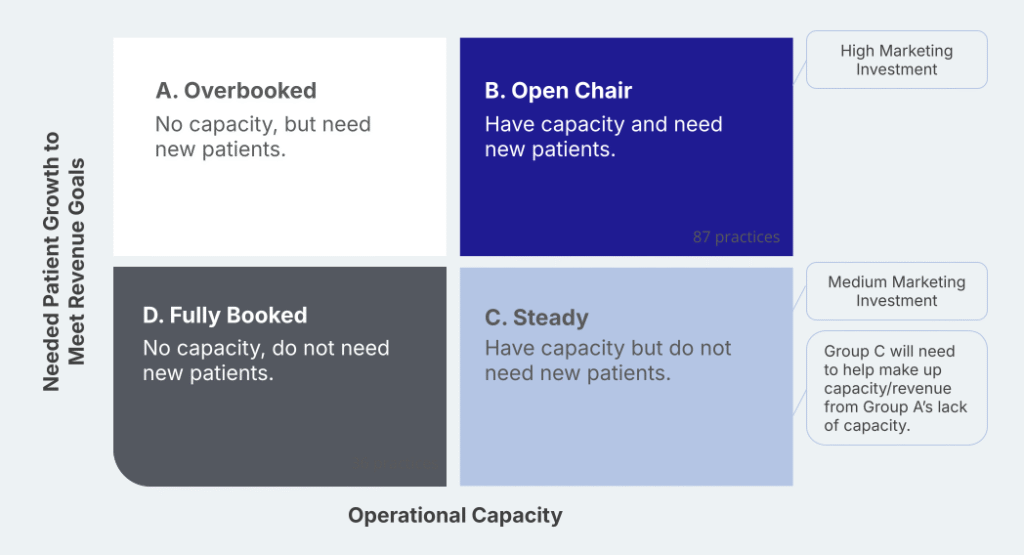Every day, healthcare marketers waste ad dollars sending patients to locations that don’t have room for them. At best, it’s inefficient. At worst, it erodes consumer trust.
If you’re running ads without knowing whether a location has the capacity to accept new patients, you’re throwing money down the drain—and possibly driving future patients straight into the arms of your competitors.
What We Mean by “Capacity”
In healthcare, capacity is defined by many names: provider utilization, appointment availability, and access. No matter what your organization calls it, capacity boils down to a simple question: Can we take on more patients at this location, right now?
Operations usually knows the answer. But marketing often doesn’t. That disconnect is a major problem when your job is to drive growth.
The Cost of Misalignment
When marketing isn’t aligned with capacity, several things go wrong:
- You waste budget. Every dollar spent advertising an overbooked practice is a dollar you could have used to fill chairs at a location with availability.
- You lose patients. People don’t wait. If your ad convinces them to book, but they can’t be seen for six weeks, they’ll find another provider who can.
- You damage your brand. Consumers associate long waits and limited access with poor service. That frustrates them and devalues your brand.
“It begins and ends with access… you’re not selling false expectations… so that the expectation you’re setting from the beginning remains true to the encounters they’re going to have.” —Alvaro Fernandez, Service Line Marketing Director, CHRISTUS Health.
What Capacity-Driven Strategy Looks Like in Action
Capacity-aligned marketing starts with a shared framework—one that helps both marketing and operations understand where patient demand exists, where provider availability is limited, and how those realities should shape your media strategy. That framework doesn’t have to be high-tech or complicated to be effective. The best approach is the one you can consistently act on.
Work with your operations team to figure out what’s practical today, not someday. Don’t let perfect be the enemy of progress—some data is better than none, and strong alignment beats sophisticated tech. Don’t forget that a well-designed Excel sheet can be a powerful tool.
What works for your group may differ from others. The key is to get on the same page about how you’re defining capacity and what marketing should do with that information.

Take North American Dental Group, a 200+ location DSO. Their team developed a quadrant system to visualize how patient demand and operational capacity should guide marketing investments. It gave them an at-a-glance view of which locations warranted high, medium, or minimal media spend, and where operational fixes were needed before marketing could make an impact.
Empower Behavioral Health, an ABA therapy provider, took a different approach. They built a simple three-tier model that categorized locations by waitlist depth, client discharge rates, and staffing status. The tiering system directly informed budget allocation and helped avoid wasted ad spend.
Whether it’s a quadrant, three-tier, or high- and low-priority framework, the goal is the same: make capacity actionable. Set benchmarks, define escalation rules, and revisit regularly. For example, if the providers hit 90% utilization, shift it to a lower investment tier. If new appointment slots open up, reevaluate.
What matters most is building a shared framework—and using it to guide real decisions.
How to Get Started: Align with Operations
You don’t need a high-tech dashboard to get started. Yes, some systems have integrated tools where marketing can see wait times and appointment availability in real time. But even a manual approach works and is better than doing nothing.
Here are a few ways to build alignment around capacity:
- Start with shared definitions. Agree on what having “capacity” means. Is it open appointment slots? Specific provider utilization thresholds? Equipment or room utilization rates? Getting aligned on language is the first step.
- Ask Ops for a location-level snapshot. Request a list that includes current provider schedules, average appointment lag times, and any known bottlenecks.
- Create a simple tiering system. Red = overbooked, Yellow = near capacity, Green = room to grow. This helps quickly identify where to invest—and where to pause.
- Set thresholds. For example: “We won’t increase the paid media budget for a location unless they have at least 10 open appointment slots in the next 3 weeks.”
- Establish a cadence. Hold monthly or bi-weekly syncs with ops. Capacity changes fast, and media plans need to keep pace.
- Integrate data where you can. Even a shared spreadsheet or simple dashboard can help teams stay aligned.
“It’s about effective communication, data utilization, and a shared goal for sustainable growth, maintaining program quality, and delivering the experience our consumers expect.” —Mari Considine, Chief Marketing & Development Officer at Acenda Integrated Health.
A Common Friction Point: “We Want Growth, But We’re Not Open”
One of the trickiest challenges marketers face is when practices or providers say they want more patients, but their schedules tell a different story. A provider might say, “Yes, I want to grow and take on more patients,” but only opens one or two new appointment slots a week. In that case, marketing can’t realistically deliver meaningful volume.
This is where tight alignment between marketing, operations, and clinical teams is essential. Everyone needs to understand what level of access is required to meet shared growth goals. If your goal is 20 new patients this month, but you’re only opening five slots, there’s a disconnect.
Getting aligned means:
- Being honest about true availability at the provider level
- Defining realistic volume goals based on access
- Ensuring operational teams are willing and able to flex schedules to support growth
“You think you want to grow, but your providers aren’t actually accepting new patients.”
As Kristina Dover, Mercy’s CMO, explains, transparency and pre-alignment with operations are essential: “We provided operations with tools to show where access was needed before we went live in a market. Once we gave that transparency, our operational leaders really partnered with us—we set thresholds for when we would see patients and when new appointment availability was needed before marketing would launch. Once they opened it up, we turned on the marketing.”
This kind of two-way planning builds trust and prevents wasted effort on all sides.
For more tactical ideas, check out this article on marketing and operations alignment.
What to Do Next: Loop In Your Agency
If you work with a media agency, make sure they have access to capacity data, too. That could mean:
- Monthly updates from your team on priority locations
- A shared scorecard that tracks capacity and media spend side-by-side
- Shared rules of engagement—e.g., “Only deploy campaigns if capacity is green”
Without this context, your agency is flying blind. With it, they can prioritize investments where you’ll see the highest return.
Final Thought: Efficiency Over Everything
Capacity-aligned marketing isn’t just a smart move—it’s essential. You’re not just optimizing the budget; you’re protecting your brand, improving the patient experience, and supporting system-wide growth goals.
If you haven’t had the capacity conversation yet, now is the time. Talk to operations. Share your goals. Build a plan. And then make sure your agency is ready to act on it.
Otherwise, you’re just pouring budget down the drain.

